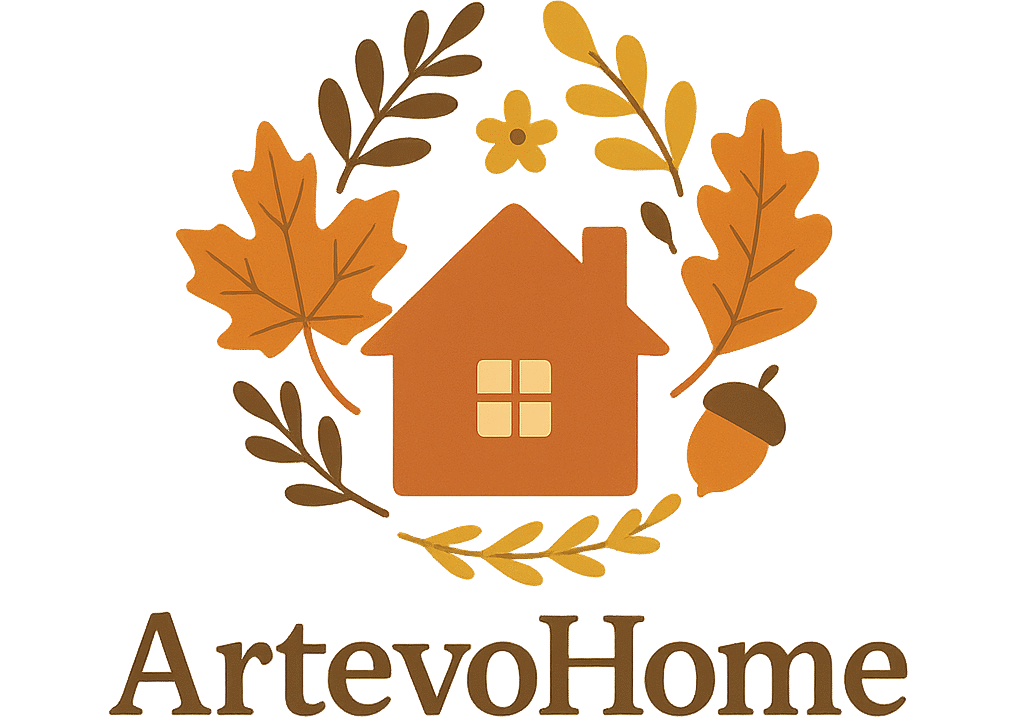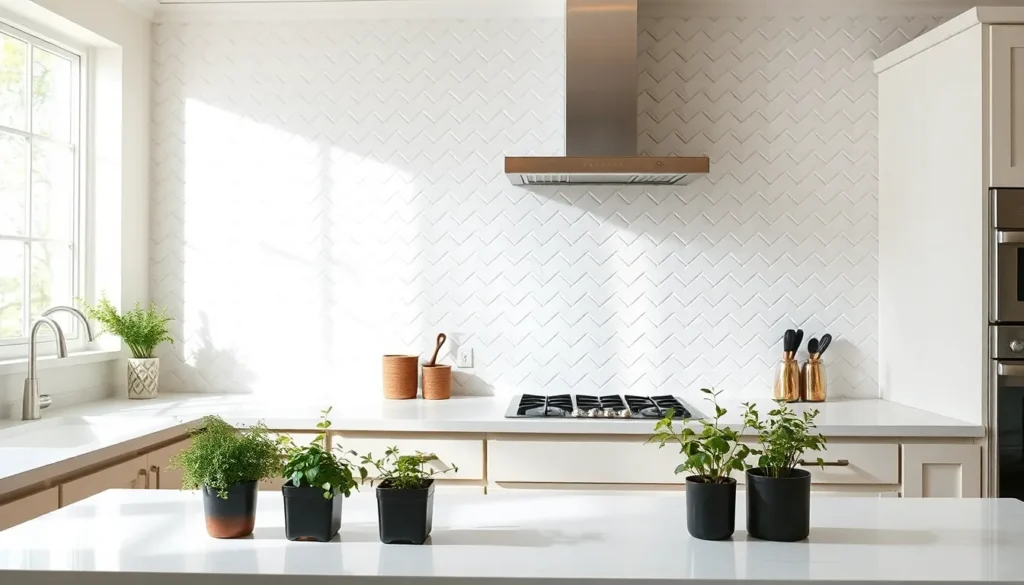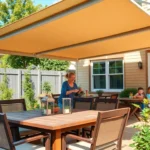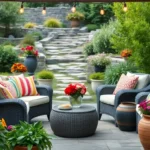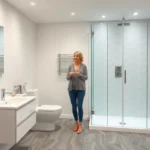When we’re designing our dream kitchen, wall tiles often become the unsung heroes that tie everything together. These versatile design elements don’t just protect our walls from splashes and stains – they’re powerful tools that can transform an ordinary cooking space into something truly spectacular.
We’ve discovered that the right kitchen wall tiles can make a small space feel larger, add personality to neutral cabinets, or create stunning focal points that guests can’t stop talking about. From classic subway tiles to bold geometric patterns, the options available today are virtually endless.
Whether you’re planning a complete kitchen renovation or simply looking to refresh your space with a stylish backsplash, we’ll guide you through the most inspiring wall tile ideas that’ll elevate your kitchen’s style and functionality. Let’s explore how these small but mighty design elements can make a massive impact on your home’s heart.
Subway Tiles: The Timeless Classic for Modern Kitchens
Subway tiles remain the most popular choice for kitchen backsplashes because they blend seamlessly with virtually any design style. We’ve seen these rectangular beauties transform countless kitchens from ordinary to extraordinary with their clean lines and versatile appeal.
Traditional White Subway Layouts
Classic horizontal brick patterns create the foundation for timeless kitchen designs that never go out of style. We typically install 3×6 inch white subway tiles in running bond layout, which offers visual stability while maintaining clean sight lines across the backsplash area.
Vertical stacking arrangements add height to kitchen spaces and create a more contemporary feel than traditional horizontal layouts. Installing subway tiles in straight vertical columns draws the eye upward, making standard 8-foot ceilings appear taller and more spacious.
Herringbone configurations bring sophisticated movement to white subway tile installations without overwhelming the kitchen’s overall design scheme. We position each tile at 45-degree angles to create zigzag patterns that add visual interest while maintaining the classic subway tile aesthetic.
Offset patterns with varied grout spacing allow homeowners to customize their backsplash appearance through strategic grout line placement. Wider grout lines (⅛ inch or more) emphasize individual tiles, while thinner lines (1/16 inch) create seamless, continuous surfaces.
Colored Subway Tile Variations
Soft sage green subway tiles complement natural wood cabinetry and brass hardware for kitchens that embrace organic, earthy design themes. We’ve installed these muted green tiles in farmhouse and transitional kitchens where homeowners want subtle color without bold statements.
Navy blue subway installations create dramatic focal points behind ranges or extend across entire backsplash areas for maximum impact. Deep blue tiles pair exceptionally well with white cabinets and gold fixtures, creating sophisticated color combinations that feel both classic and contemporary.
Charcoal gray subway tiles offer neutral alternatives to stark white while maintaining the timeless subway tile silhouette. We recommend charcoal tiles for kitchens with stainless steel appliances and cool-toned countertops like quartz or marble.
Terracotta orange subway tiles bring warmth and Mediterranean flair to kitchen designs that feature natural materials and warm color palettes. These earthy tiles work particularly well in kitchens with wood beams, copper accents, or warm white cabinets.
Textured and Beveled Options
Beveled edge subway tiles create subtle shadow lines that add dimensional interest without departing from the classic subway tile format. We install beveled tiles when homeowners want traditional subway appeal with enhanced visual texture and light reflection properties.
Handmade subway tiles with irregular surfaces introduce artisanal character through slight variations in thickness, edge definition, and surface texture. These handcrafted tiles cost 20-30% more than machine-made options but deliver unique personality that mass-produced tiles cannot match.
Glazed subway tiles with crackle finishes provide vintage charm through intentional surface crackling that develops during the firing process. We’ve used crackle-finished subway tiles in cottage-style kitchens and spaces that require authentic vintage character.
Matte finish subway tiles eliminate glossy reflections while maintaining easy cleaning properties essential for kitchen backsplash applications. Matte surfaces hide water spots and fingerprints better than high-gloss alternatives, making them practical choices for busy kitchen environments.
Natural Stone Tiles: Bringing Organic Beauty to Your Walls
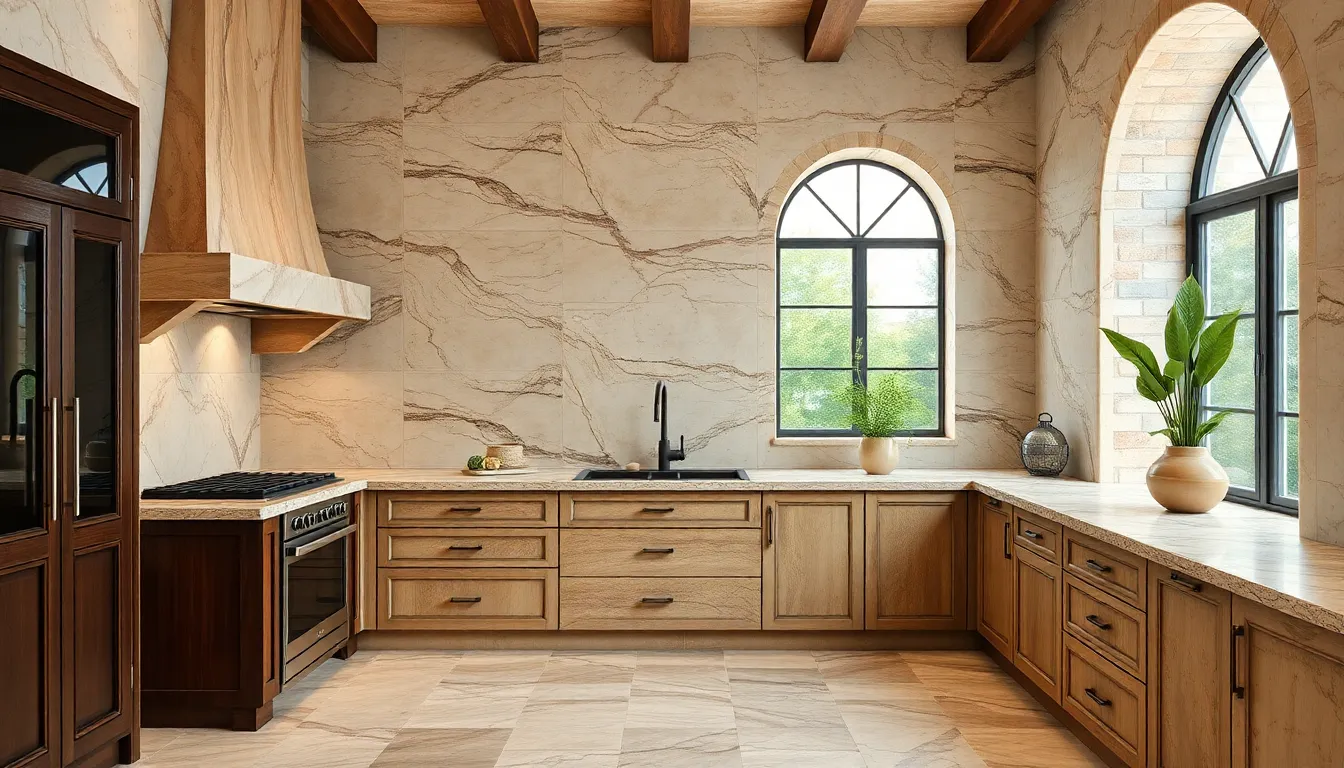
Natural stone tiles transform kitchen walls into stunning focal points that celebrate nature’s artistry. We’ll explore three exceptional natural stone options that bring timeless elegance and unique character to your kitchen design.
Marble Tile Elegance
Marble tiles deliver unmatched luxury with their distinctive veining patterns and polished surfaces. Each tile features unique natural markings that create a custom appearance, ensuring no two installations look identical. We recommend these premium stones for homeowners seeking refined sophistication in their kitchen walls.
Polished marble surfaces reflect light beautifully, making smaller kitchens appear more spacious and bright. The natural variation in marble creates visual interest without overwhelming your design scheme. Regular sealing protects these porous stones from kitchen spills and stains, preserving their elegant appearance for years.
Installation requires specialized expertise due to marble’s weight and precision cutting needs. We suggest consulting professional installers to achieve the flawless finish these luxury tiles deserve.
Travertine and Limestone Options
Travertine tiles bring warm, earthy tones that instantly create Mediterranean or Tuscan atmospheres in your kitchen. Their subtly textured surfaces add depth and visual interest to wall installations. We often recommend travertine for homeowners wanting relaxed, welcoming kitchen environments.
Limestone offers softer appearances in neutral color palettes that blend seamlessly with various design styles. These understated stones provide elegant backdrops that highlight your cabinetry and countertops without competing for attention. Both materials require protective sealing to guard against moisture and kitchen-related staining.
Neutral tones in limestone and travertine complement both modern and traditional kitchen designs. We find these stones particularly effective in open concept spaces where kitchen walls need to harmonize with adjacent living areas.
Slate Tile Rustic Appeal
Slate tiles showcase natural color variations ranging from deep grays and blues to rich earthy browns. Their slightly textured surfaces create organic, grounded feelings that work perfectly in farmhouse and industrial kitchen designs. We appreciate slate’s durability compared to other natural stone options.
Rustic charm emerges naturally from slate’s authentic surface patterns and mineral deposits. These tiles resist stains better than marble or limestone, though we still recommend periodic sealing for optimal protection against kitchen grease and grime. Visual interest develops from slate’s natural striations and color depth.
Specialized cleaning with pH neutral answers maintains slate’s appearance while protecting its natural properties. We suggest avoiding acidic cleaners that can damage the stone’s surface and compromise its protective qualities.
Mosaic Tiles: Creating Stunning Visual Interest
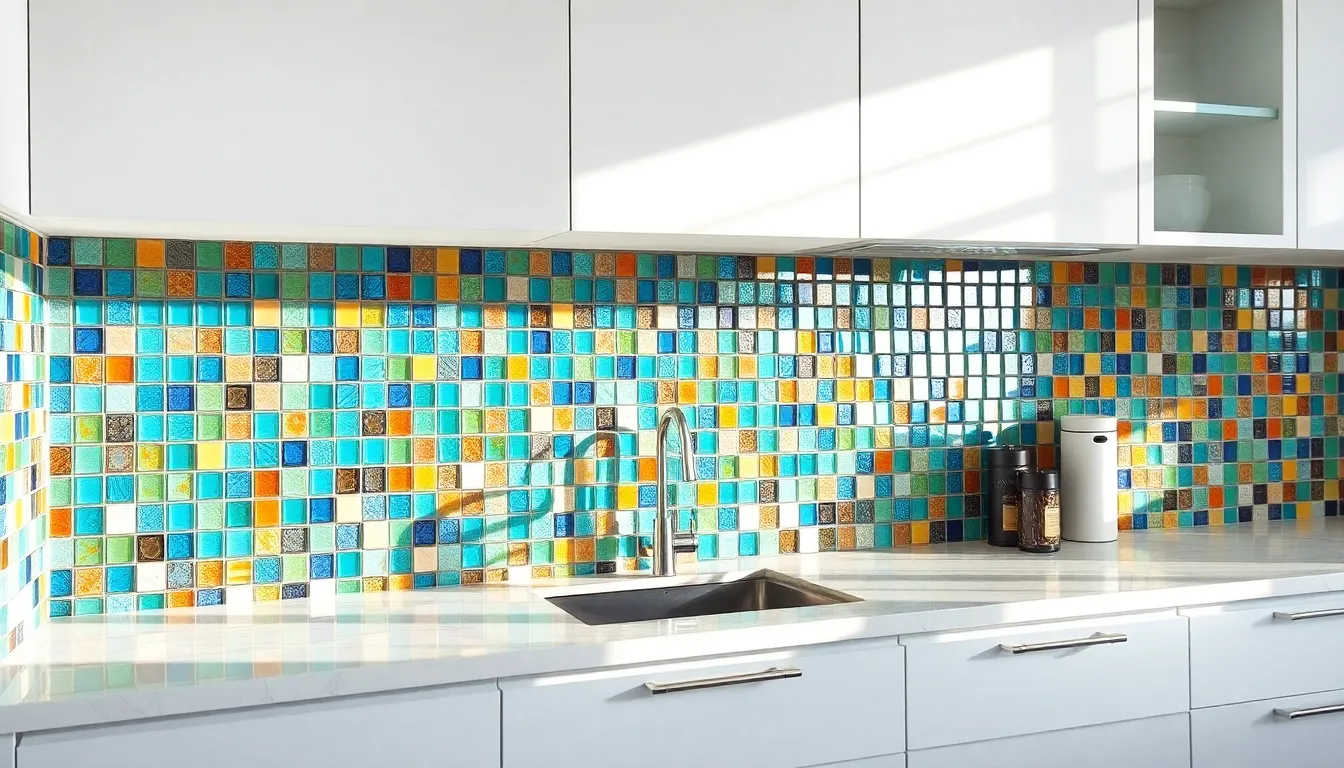
Mosaic tiles offer endless possibilities for creating custom patterns that transform ordinary kitchen walls into stunning focal points. These versatile tiles come in various sizes, colors, and materials, allowing you to design everything from leaf-shaped patterns like the Bardot Grey tile to abstract arrangements that add personality to both modern and classic kitchens.
Glass Mosaic Patterns
Glass mosaic tiles excel at brightening kitchens through their exceptional reflective qualities that bounce light throughout the space. Their wide array of colors and finishes ranges from iridescent to matte options, giving you flexibility to create either subtle backgrounds or bold artistic statements.
Cleaning becomes effortless with glass mosaics since they resist moisture and stains naturally. Installation flexibility allows for intricate patterns that can showcase your personal style while maintaining the practical benefits needed in busy kitchen environments.
Arranging these tiles in custom configurations lets you create movement and visual flow across your backsplash area. Light reflection properties make even smaller kitchens appear more spacious and welcoming.
Stone and Metal Combinations
Stone and metal mosaic combinations introduce compelling contrasts between natural textures and contemporary shine. Stone elements provide earthy, organic appeal while metal accents in copper, brass, or stainless steel add modern sophistication to your kitchen design.
Durability becomes a major advantage when combining these materials, as both stone and metal withstand daily kitchen activities exceptionally well. Visual impact increases dramatically when you blend the warmth of natural stone with the sleek finish of metallic elements.
Luxury aesthetics emerge naturally from these material pairings, creating backsplashes that serve as conversation pieces. Balance between texture and smoothness gives your kitchen walls dimensional interest that changes throughout the day as lighting shifts.
Geometric Mosaic Designs
Geometric patterns are transforming contemporary kitchen design through ever-changing layouts like hexagon, arabesque, and chevron arrangements. Hexagon tiles create visual movement whether you choose large statement pieces or smaller detailed installations.
Arabesque shapes bring an intriguing antique meets modern aesthetic that works beautifully in transitional kitchen styles. These curved, flowing forms soften the hard lines typically found in kitchen cabinetry and appliances.
Chevron styling achieves remarkable depth by arranging rectangular or subway tiles at strategic angles across your wall surface. This angular approach makes kitchen spaces appear more lively and textured while maintaining clean, organized visual flow.
Character development happens naturally with geometric patterns as they create rhythm and repetition that draws the eye across your kitchen walls. Movement and energy emerge from these carefully planned arrangements, making your kitchen feel more ever-changing and captivating.
Large Format Tiles: Achieving a Sleek Contemporary Look
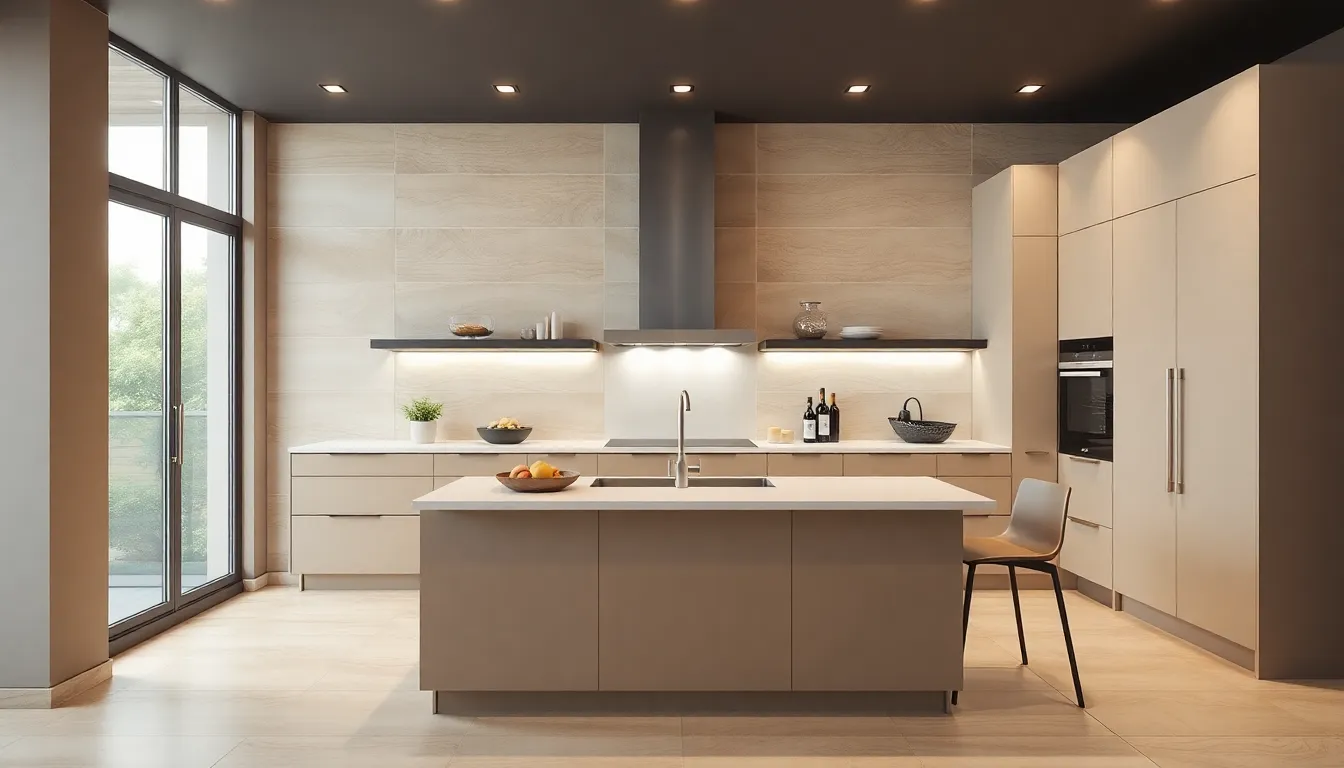
Large format tiles represent the pinnacle of modern kitchen design, offering expansive surfaces that create seamless, sophisticated wall treatments. We’ve seen these oversized tiles transform countless kitchens by making spaces feel more open and airy while delivering that coveted contemporary aesthetic.
Minimal Grout Line Benefits
Fewer grout lines create a cleaner, more streamlined appearance that defines modern kitchen design. We appreciate how large format tiles dramatically reduce the visual interruption of grout, resulting in walls that appear as continuous surfaces rather than fragmented patterns.
Maintenance becomes significantly easier when there are fewer grout lines to clean and maintain. We find that homeowners spend less time scrubbing between tiles, as the reduced grout surface area means fewer places for dirt, grease, and stains to accumulate.
Visual expansion occurs naturally when grout lines are minimized, making even compact kitchens feel more spacious. We notice that the uninterrupted surface creates an optical illusion that pushes walls outward, improving the perception of room size.
Color and Pattern Options
Monochromatic schemes work beautifully with large format tiles, allowing subtle variations in tone and texture to take center stage. We recommend solid colors like crisp whites, warm grays, or soft beiges that complement contemporary cabinetry and countertops.
Intricate patterns gain impact when displayed across larger tile surfaces, creating stunning focal points without overwhelming the space. We’ve installed tiles featuring marble veining, wood grain textures, and geometric designs that showcase their full beauty on expansive surfaces.
Personalization opportunities expand through the vast array of available finishes, from matte ceramics to polished porcelain and natural stone looks. We help homeowners select tiles that match their exact style preferences, whether they prefer minimalist elegance or bold statement walls.
Installation Considerations
Substrate preparation requires meticulous attention to ensure the surface is perfectly level and stable enough to support heavier large format tiles. We always verify that walls can handle the additional weight and make necessary reinforcements before installation begins.
Specialized cutting tools become necessary due to the substantial size of these tiles, particularly when fitting around outlets, switches, or corners. We use professional grade wet saws and diamond blades to achieve clean, precise cuts without cracking or chipping.
Appropriate adhesive selection proves critical for maintaining the integrity and appearance of large format installations. We choose high strength adhesives specifically formulated for oversized tiles and apply them using proper techniques to prevent sagging or uneven surfaces.
Patterned Tiles: Adding Personality and Character
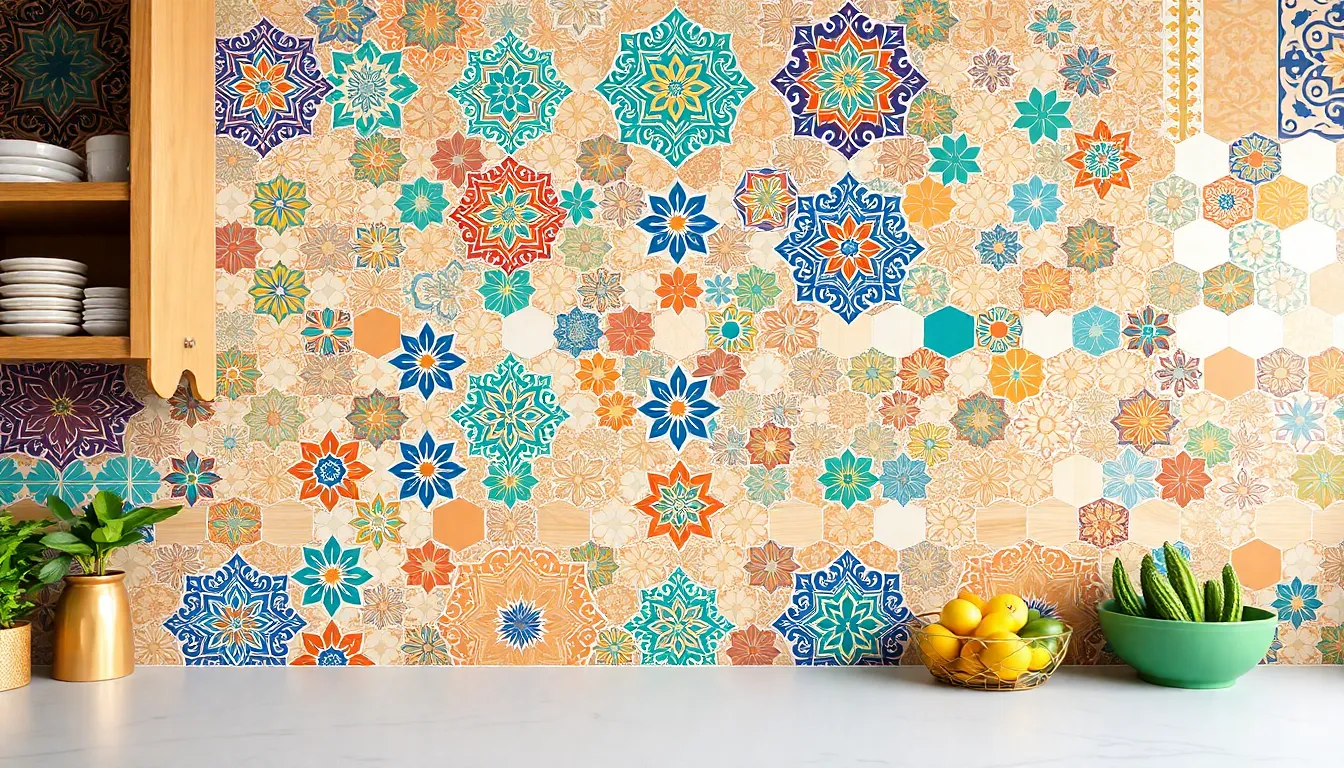
Patterned tiles transform kitchen walls from simple functional surfaces into ever-changing design statements that reflect personal style and cultural influences. These distinctive choices allow us to infuse our kitchens with character while maintaining practical durability.
Moroccan and Turkish Inspirations
Moroccan and Turkish inspired tiles bring centuries of artisanal tradition into modern kitchen designs. Intricate arabesque motifs feature flowing curves and interlacing patterns that create mesmerizing visual depth on backsplash walls. Iznik designs showcase vibrant blues, turquoise, and coral tones with delicate floral details reminiscent of Ottoman palace ceramics.
Handcrafted Zellige tiles offer authentic texture variations that catch light differently across each surface, creating an organic shimmer effect. These traditional Moroccan tiles come in rich jewel tones like emerald green, sapphire blue, and deep terracotta that instantly warm neutral kitchen palettes. Floral motifs from Turkish design traditions incorporate stylized tulips, carnations, and vine patterns that soften contemporary kitchen lines.
Nara Arabesque tiles demonstrate how cultural heritage adapts to modern spaces through simplified geometric interpretations of classic motifs. Bold color choices like vivid orange or deep navy create striking focal points, while softer pastels maintain subtle elegance. Grout selection dramatically impacts the final appearance, with contrasting colors emphasizing pattern details and matching tones creating seamless textile effects.
Geometric Pattern Layouts
Hexagon patterns offer versatility through size variation that dramatically changes visual impact and room perception. Large hexagon tiles create bold modern farmhouse statements that complement shiplap walls and industrial fixtures. Small hexagon mosaics provide subtle movement and texture that works beautifully in transitional kitchen designs.
Diamond arrangements add sophisticated angles that draw eyes upward and make ceiling heights appear more generous. These patterns work particularly well behind ranges where they create stunning focal points without overwhelming surrounding cabinetry. Herringbone layouts using rectangular tiles introduce ever-changing movement that energizes galley kitchens and narrow spaces.
Windmill patterns combine squares and rectangles in rotating arrangements that create playful rhythm across backsplash areas. Checkerboard designs offer timeless appeal through high contrast combinations like black and white or navy and cream. Mixed geometric combinations allow us to layer different patterns within the same space, using larger patterns as foundations and smaller accents for detail work.
Vintage and Retro Designs
Mid-century inspired tiles capture the optimism and bold color palettes of 1950s and 1960s design movements. Pastel shades like mint green, powder blue, and soft pink create cheerful kitchen atmospheres that pair beautifully with brass fixtures and walnut cabinetry. Repeating atomic patterns and boomerang motifs add authentic period character to contemporary renovations.
Art deco aesthetics translate beautifully to kitchen wall tiles through stepped patterns, sunburst designs, and metallic accents. Rounded tile shapes and scalloped edges soften harsh architectural lines while maintaining sophisticated appeal. These curved profiles work particularly well in breakfast nooks and coffee bar areas where softer energy enhances relaxation.
Subway tiles receive fresh interpretations through non-traditional colors, unique finishes, and creative layout arrangements. Running bond patterns in sage green or terracotta orange bring unexpected warmth to classic designs. Basket weave layouts using traditional subway dimensions create texture through shadow play and dimensional interest. Contrasting grout lines amplify retro aesthetics by emphasizing tile boundaries and creating graphic grid effects that complement vintage appliances and period appropriate hardware.
Textured Tiles: Incorporating Tactile Elements
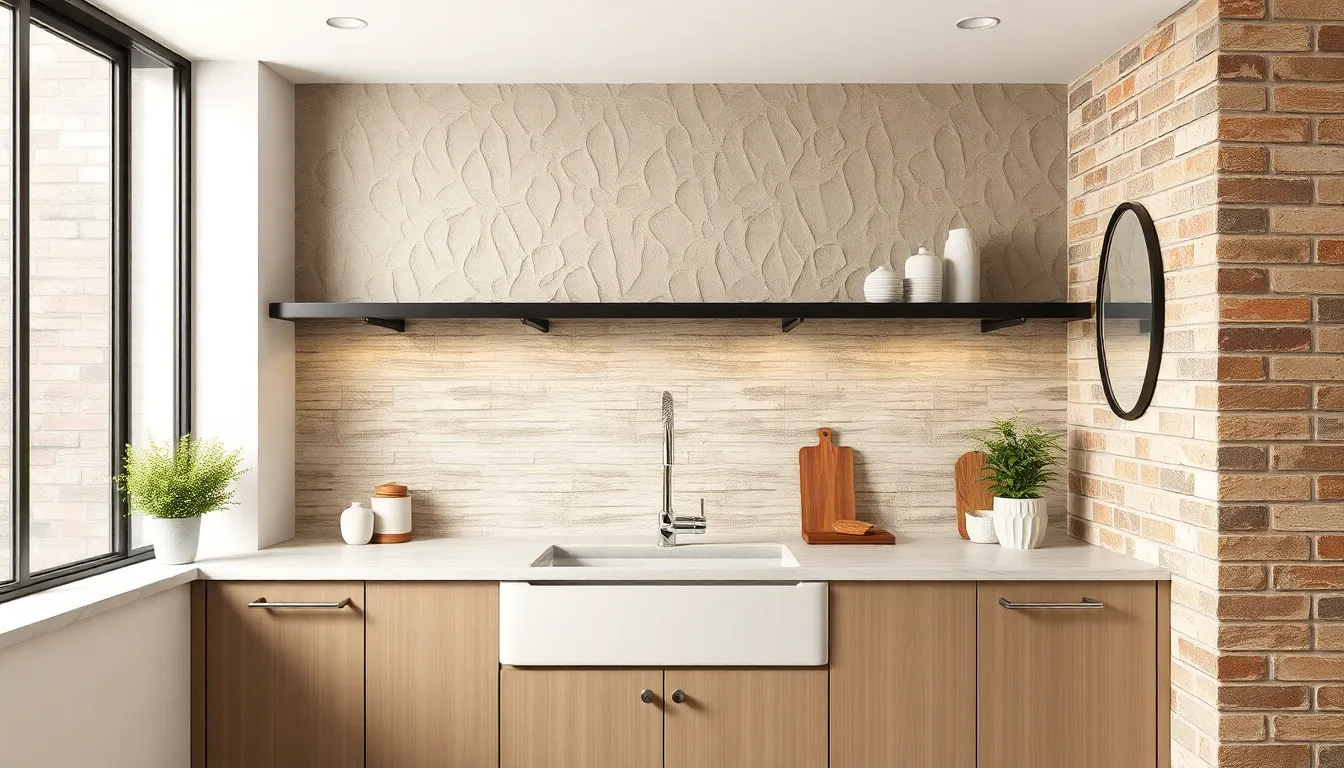
Textured tiles transform kitchen walls from flat surfaces into ever-changing focal points that invite touch and visual exploration. These dimensional options create depth and character while adding warmth to your cooking space.
Three-Dimensional Wall Tiles
Sculptural effects define the appeal of three-dimensional wall tiles, which elevate kitchen aesthetics through ever-changing shadows and architectural interest. Modern kitchens benefit from these bold design elements that create contemporary focal points behind stoves or sinks. Various shapes and patterns allow you to customize the visual impact, from subtle wave patterns to dramatic geometric reliefs.
Strategic placement maximizes the impact of 3D tiles without overwhelming your kitchen design. We recommend using them as accent walls or backsplash features rather than covering entire surfaces. Light plays beautifully across these textured surfaces, creating ever-changing visual effects throughout the day that enhance the sophisticated atmosphere of your cooking space.
Hand-Painted Artisan Options
Craftsmanship shines through hand-painted artisan tiles that bring unique patterns and colors to your kitchen walls. Each tile reflects individual artistry, ensuring no two installations look exactly alike. Globally inspired designs and locally crafted motifs serve as artistic accents that transform utilitarian spaces into personal galleries.
Artistic functionality combines beauty with practicality in collections like the Nikki Chu Tangier series, which features hand-drawn graphic motifs that mimic wallpaper while maintaining porcelain’s easy-clean benefits. These tiles suit eclectic, Mediterranean, or vintage-themed kitchens perfectly. Cultural character emerges through these personalized design choices that reflect your individual style and heritage.
Brick and Wood-Look Alternatives
Natural textures come alive through brick and wood-look tiles that offer rustic charm with ceramic or porcelain durability. Industrial and farmhouse vibes emerge from brick-look options, while wood-look alternatives add warmth without concerns about warping or water damage. These practical answers maintain the aesthetic appeal of natural materials while providing superior maintenance ease.
Versatile styling makes these alternatives perfect for various design themes, from rustic farmhouse to modern industrial and Scandinavian minimalism. Durability exceeds that of actual brick or wood, making these tiles ideal for high-moisture kitchen environments. Installation remains straightforward compared to authentic materials, while the visual impact delivers the cozy, organic feel you desire for your cooking space.
Metal Tiles: Introducing Industrial Chic Style
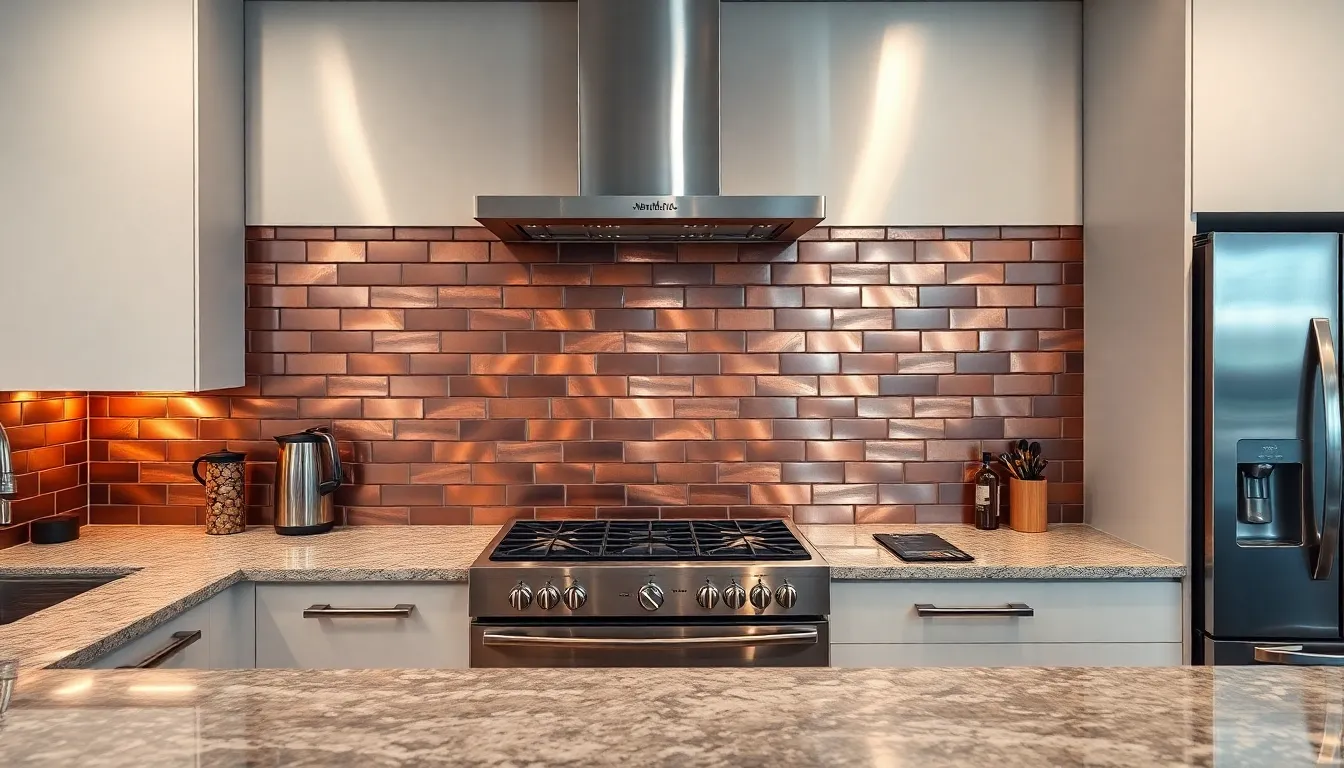
Metal tiles bring sophisticated urban aesthetics to kitchen walls while delivering exceptional durability and performance. These materials create striking focal points that perfectly complement contemporary design themes.
Stainless Steel Backsplashes
Stainless steel tiles offer sleek, modern appeal that’s become increasingly popular in industrial style kitchens. Their reflective surfaces create visual depth while providing superior resistance to heat, moisture, and stains.
We recommend stainless steel for its low maintenance requirements and professional grade durability. The material’s neutral metallic finish coordinates beautifully with stainless steel appliances, creating cohesive design flow throughout the space.
Installation typically involves standard adhesive methods, though proper surface preparation ensures optimal adhesion. These tiles work exceptionally well behind cooktops and ranges where heat resistance is crucial.
Copper and Bronze Finishes
Copper and bronze finishes introduce rich, luxurious tones that warm up kitchen environments while maintaining industrial authenticity. These metals develop beautiful patina over time, adding character and unique aging patterns to wall surfaces.
Bronze tiles complement stone and glass elements particularly well, creating sophisticated layered designs. Their warm undertones balance cooler materials like granite countertops or stainless steel fixtures.
We’ve observed copper’s natural antimicrobial properties make it an excellent choice for kitchen applications. The material requires minimal maintenance beyond regular cleaning with appropriate copper exact products.
Aluminum Tile Applications
Aluminum tiles provide lightweight alternatives to stainless steel while delivering comparable durability and contemporary aesthetics. Their brushed or polished finishes create subtle texture variations that enhance visual interest on kitchen walls.
These tiles excel in moisture prone areas due to aluminum’s natural corrosion resistance. We find they’re particularly effective in smaller kitchens where their lighter weight simplifies installation processes.
Color options include natural silver, black anodized, and custom powder coated finishes that expand design possibilities. Aluminum’s recyclable nature also appeals to environmentally conscious homeowners seeking sustainable material choices.
Glass Tiles: Maximizing Light and Openness
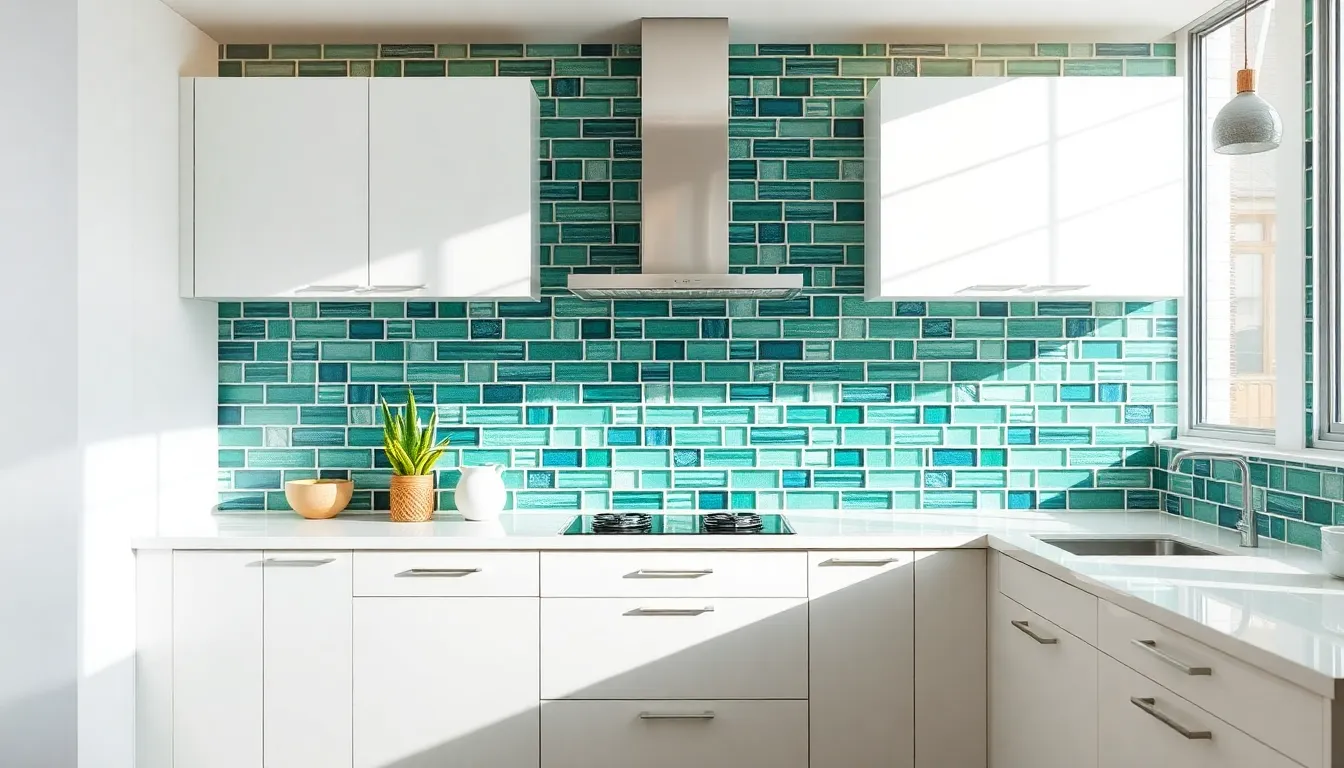
Glass tiles excel at transforming kitchens through their exceptional ability to reflect light and create visual space. We find these versatile options particularly effective for maximizing brightness in smaller or darker kitchen environments.
Transparent and Translucent Options
Transparent glass tiles create remarkable depth by revealing the wall surfaces or colored backing behind them, generating a luminous quality that expands visual space. We recommend these clear options for kitchens where maximizing natural light transmission is essential. Translucent varieties offer a softer approach, diffusing light gently to create a subtle glow throughout the space.
Installation of transparent tiles works exceptionally well in compact kitchens where visual expansion is crucial. Light bounces off these surfaces to brighten darker corners and create an open, airy atmosphere. We’ve observed that translucent options provide the perfect balance between privacy and illumination, making them ideal for backsplashes that face neighboring windows or open floor plans.
Frosted Glass Variations
Frosted glass tiles deliver privacy without sacrificing light transmission through their etched or sandblasted matte finish. We appreciate how these tiles diffuse light gently while reducing unwanted glare from overhead fixtures or natural sources. Contemporary kitchens benefit significantly from frosted glass surfaces that complement various cabinet and countertop materials seamlessly.
Cleaning becomes effortless with frosted glass tiles due to their smooth surface texture that resists stains and fingerprints. We find these variations particularly suitable for both backsplashes and full height accent walls. Installation versatility allows frosted glass to work beautifully in herringbone, subway, and basketweave patterns for added visual interest.
Colored Glass Statement Walls
Colored glass tiles transform ordinary kitchen walls into bold focal points through their spectrum of available hues including deep greens, blues, reds, and sophisticated neutrals. We recommend mixed color glass mosaics for their exceptional reflective properties that catch and distribute light throughout the space. Statement walls in colored glass serve as dramatic focal points while harmonizing with existing room palettes.
Large format colored glass sheets create striking visual impact when installed as feature walls behind ranges or sinks. We’ve seen vibrant and energetic kitchen transformations using these tiles in mosaic patterns that make spaces feel ever-changing and lively. Installation patterns like herringbone and basketweave layouts enhance the decorative appeal while maintaining the functional benefits of easy maintenance and stain resistance.
Mixed Material Combinations: Blending Different Tile Types
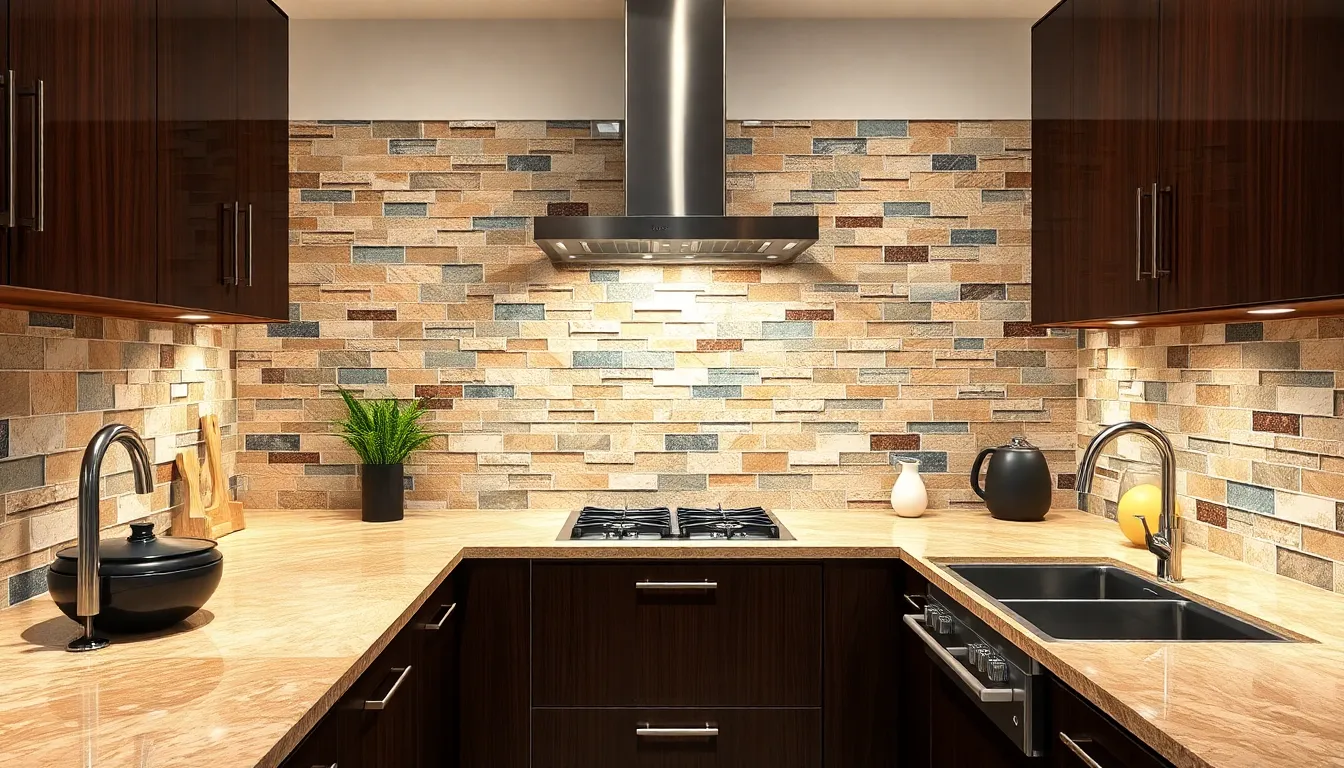
We can create truly stunning kitchen walls by thoughtfully combining different tile materials and styles. This approach adds visual interest and depth while allowing us to personalize our kitchen’s aesthetic.
Stone and Glass Pairings
Natural stone tiles paired with glass elements create a perfect balance of earthiness and brilliance. We recommend combining marble or travertine with glass mosaic tiles to achieve this harmonious contrast. Stone provides the organic texture and depth that grounds the design, while glass adds reflective shine that helps expand smaller kitchens visually.
Glass mosaic accents work exceptionally well behind cooking areas and sinks. We often see this combination used as backsplashes where the stone’s durability meets glass’s easy maintenance requirements. The natural veining in marble creates stunning focal points when complemented by shimmering glass tiles that catch and reflect kitchen lighting throughout the day.
Large glass accent tiles can amplify the impact of natural stone installations. We suggest using travertine as the primary field tile with strategic glass panel insertions to create sophisticated geometric patterns. This pairing brings together stone’s timeless appeal with glass’s contemporary lightness.
Metal and Ceramic Combinations
Metal tiles introduce sleek modern contrast when paired with ceramic or porcelain options. We find that stainless steel strips work beautifully as accent borders around ceramic field tiles, creating clean industrial lines. This combination offers endless color possibilities through ceramic options while metal elements add sophisticated metallic highlights.
Copper tiles create warm focal points against neutral ceramic backgrounds. We recommend using copper as accent strips or feature panels within larger ceramic installations. The ceramic provides durability and cost effectiveness while copper develops beautiful patina over time that adds character to the overall design.
Installation compatibility becomes crucial when mixing metal and ceramic materials. We always ensure both tile types have similar thickness requirements and use appropriate backing materials for proper support. The contrast between metal’s sleek finish and ceramic’s versatile surface creates ever-changing kitchen walls that feel both modern and approachable.
Texture Mixing Strategies
Glossy and matte finishes create compelling visual contrasts when strategically combined. We pair reflective glass or ceramic tiles with matte stone or wood look options to achieve ever-changing surface variation. Glossy tiles brighten spaces by reflecting light while matte textures add sophisticated tactile interest that invites closer inspection.
Smooth surfaces balanced with textured elements prevent monotonous wall treatments. We recommend mixing sleek subway tiles with three dimensional options like brick textured ceramics or natural stone with visible grain patterns. This strategy ensures kitchen walls have both visual depth and physical texture that creates captivating focal points.
Grout selection becomes especially important in mixed texture installations. We choose grout colors that either highlight the texture differences or create seamless blending between materials. Light grout emphasizes individual tile characteristics while darker options create unified fields that let texture variations shine through subtle shadow play.
Budget-Friendly Tile Ideas: Stylish Options Without Breaking the Bank
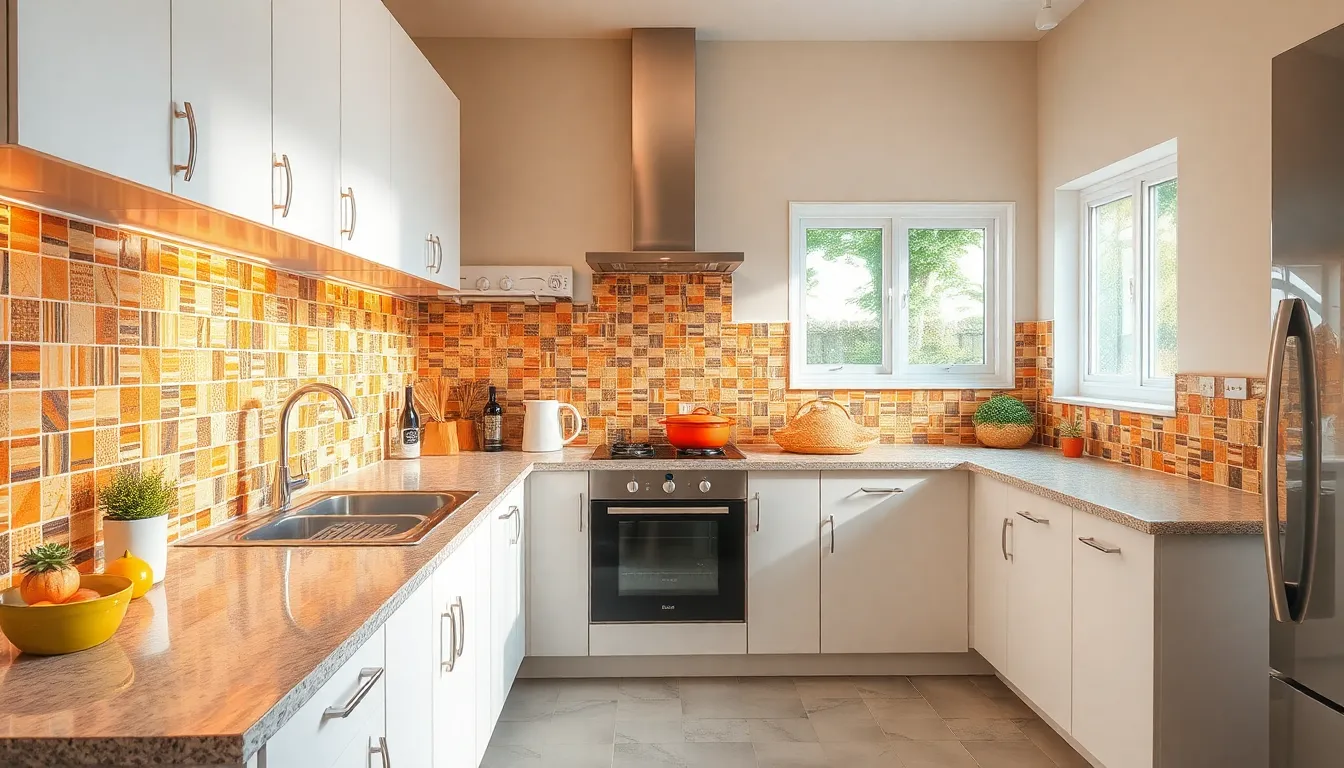
Creating stunning kitchen wall tiles doesn’t require a luxury budget. Smart alternatives and strategic planning can deliver impressive results while keeping costs between $5 and $20 per square foot.
Ceramic Tile Alternatives
Adhesive peel-and-stick tiles offer the easiest installation method for budget-conscious homeowners. These versatile options cost between $5 and $15 per square foot and come in countless designs that mimic ceramic, stone, and even metal finishes. Application requires no special tools or professional skills, making them perfect for weekend DIY projects.
Mosaic tile sheets create high-end appearances at affordable prices ranging from $5 to $20 per square foot. Pre-arranged designs eliminate the guesswork of individual tile placement while delivering professional-looking results. Glass mosaic varieties reflect light beautifully, making smaller kitchens appear more spacious.
Painted plywood panels provide creative alternatives that cost significantly less than traditional tiles. Waterproof sealers protect the surface while allowing custom colors and patterns that match your exact design vision. Metal sheets offer industrial aesthetics at fraction of the cost of genuine metal tiles.
Waterproof wallpaper mimics tile patterns with remarkable accuracy while requiring minimal installation effort. Modern vinyl options resist moisture and grease, making them practical for kitchen environments. Removal becomes simple when you’re ready for design changes.
Repurposed materials unlock unique design possibilities at minimal expense. Marble scraps from countertop installations create luxurious backsplashes, while recycled table mats can serve as creative tile alternatives with proper sealing.
DIY Installation Tips
Wall preparation determines the success of your tile installation project. Clean surfaces thoroughly with degreasing agents to ensure proper adhesion, especially in areas exposed to cooking residue. Level walls using compound to create smooth foundations for your tiles.
Strategic starting points ensure balanced, professional appearances. Begin mosaic sheet installations at the wall’s center point to maintain symmetry across the entire surface. Mark guidelines with chalk lines to maintain straight horizontal and vertical alignments.
Cutting techniques vary based on your chosen tile material. Utility knives work well for peel-and-stick options, while wet saws deliver precise cuts for mosaic sheets. Score and snap methods suit thinner materials, reducing waste and ensuring clean edges.
Grout application adds visual interest through color contrast choices. Darker grout lines emphasize individual tiles, while lighter options create seamless appearances. Clean excess grout immediately to prevent permanent staining on tile surfaces.
Installation timing affects final results significantly. Work in manageable sections to prevent adhesive from drying before tile placement. Allow proper curing time between installation and grout application for optimal bond strength.
Where to Find Affordable Options
Home improvement stores stock extensive selections of budget-friendly tile options. Major retailers offer competitive pricing on ceramic alternatives, adhesive tiles, and mosaic sheets. Clearance sections often contain discontinued styles at substantial discounts.
Dollar stores provide surprising resources for DIY tile projects. Decorative materials, installation tools, and creative alternatives appear regularly in these budget-focused retailers. Adhesive products and basic tools cost significantly less than specialty tile suppliers.
Online retailers expand your options beyond local inventory limitations. Pinterest showcases curated collections of budget-friendly kitchen tile ideas shared by homeowners worldwide. Community recommendations highlight successful project outcomes and cost-saving strategies.
Specialty tile suppliers like Tile Hub offer professional guidance alongside affordable product selections. Expert advice helps maximize your budget while achieving desired aesthetic results. BHG provides comprehensive guides for stylish, cost-effective wall tile answers.
Salvage yards contain reclaimed materials that add character while reducing costs. Architectural salvage companies often stock vintage tiles, stone pieces, and unique materials unavailable through traditional retailers. Inspection ensures structural integrity before purchase.
Conclusion
We’ve explored a diverse range of kitchen wall tile options that can transform your space from ordinary to extraordinary. Whether you’re drawn to the timeless appeal of subway tiles or the bold statement of patterned designs your choice of wall tiles will define your kitchen’s character.
From budget-conscious DIY answers to luxurious natural stone installations there’s a perfect tile option for every style and budget. We’ve seen how texture dimension and color can work together to create stunning focal points that reflect your personal aesthetic.
Your kitchen renovation journey doesn’t have to be overwhelming. With the right tile selection and proper installation techniques you’ll create a space that’s both beautiful and functional for years to come.
Frequently Asked Questions
What are the most popular types of kitchen wall tiles?
The most popular kitchen wall tiles include subway tiles (in white and various colors), natural stone options like marble and travertine, glass mosaics, and large format tiles. Subway tiles remain timeless due to their versatility, while natural stone adds luxury. Glass mosaics offer reflective qualities that brighten spaces, and large format tiles create modern, seamless looks.
How much do kitchen wall tiles typically cost?
Kitchen wall tiles can range from budget-friendly options at $5-20 per square foot to luxury materials costing significantly more. Affordable alternatives include peel-and-stick tiles, mosaic sheets, and ceramic options. Natural stone and handcrafted tiles typically cost more but offer unique beauty and durability for those with larger budgets.
Can I install kitchen wall tiles myself?
Yes, many kitchen wall tiles can be DIY-installed with proper preparation and tools. Key steps include wall preparation, starting from the center point, using appropriate cutting techniques, and proper grout application. However, large format tiles and natural stone may require professional installation due to their weight and specialized requirements.
What tile patterns work best for small kitchens?
For small kitchens, vertical subway tile layouts, large format tiles with minimal grout lines, and light-colored options help create the illusion of more space. Avoid busy patterns that can overwhelm compact areas. Geometric patterns like hexagons can add interest while maintaining a clean, organized appearance that enhances spatial perception.
How do I choose between subway tiles and mosaic tiles?
Choose subway tiles for timeless versatility, easy maintenance, and budget-friendly options. They work well with various design styles and offer multiple layout possibilities. Select mosaic tiles when you want to create focal points, add texture and visual interest, or incorporate multiple colors. Mosaics offer more design flexibility but may require more maintenance.
What’s the difference between natural stone and ceramic tiles?
Natural stone tiles like marble and travertine offer unique patterns and luxury appeal but require sealing and more maintenance. Ceramic tiles are more affordable, easier to maintain, water-resistant, and available in numerous designs including stone-look alternatives. Ceramic provides durability and practicality, while natural stone offers authentic beauty and character.
Are textured tiles practical for kitchen walls?
Textured tiles can be practical for kitchen walls when used strategically. Three-dimensional and hand-painted tiles work well as accent features or backsplashes but may require more cleaning effort. Wood-look and brick-look textured tiles offer rustic charm with ceramic durability, providing easier maintenance than actual wood or brick materials.
How do I maintain different types of kitchen wall tiles?
Maintenance varies by tile type: ceramic and glass tiles need regular cleaning with mild detergents, natural stone requires periodic sealing and pH-neutral cleaners, while textured tiles may need more detailed cleaning in grooves. Large format tiles with fewer grout lines are easier to maintain, and quality sealing helps protect all tile types from stains and moisture.
